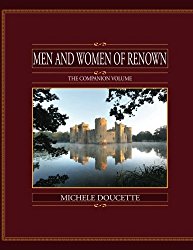Book 19: Men and Women of Renown: The Companion Volume
Men and Women of Renown: The Companion Volume is the second maternal genealogy tome from this author.
The early Acadian settlers were mostly farmers. Farms were located along the banks of rivers that flowed into the Baie Française (Bay of Fundy) with Grand-Pré being the great agricultural area of the colony. Rather than clear the uplands, the Acadians drained the marshes along bays and rivers by building dykes (large, tall mounds of earth covered with grass) and aboiteaux (drainage systems with trap doors that let water out, but not back in) to keep sea water out. An amazing people, the Mothers of Acadia mtDNA Project is serving to paint a picture of the wondrous mtDNA diversity amongst the French Acadian women.
Filles du Roi was a term that meant meaning daughters (wards) of the King. These ladies, in large part, started the French Canadian population explosion that has, over 350 years, spread across North America. With fur traders, storekeepers, indentured servants, dockhands, clerics, farmers, settlers, and soldiers in New France, the population was mostly men; hence, the King quickly came to realize that for this new colony to thrive there must be marriageable women. As a result, the King offered 50 livres dowry to each, in addition to whatever the lady brought with her; he also sponsored her transportation. Of the nearly 1000 women who undertook the journey, between 1663 and 1673, about 800 made it to Canada. These were not ladies of ill repute; some were from wealthy families. With all that is written about them, the details of why they chose to come to New France are, for the most part, lost to history. One can only hope that at least one made the journey merely to experience the unknown and satisfy a pioneer spirit.
With Catherine de Baillon, a notable ancestress, identified in Men and Women of Renown: My Maternal Ancestry, demonstrating a proven medieval lineage back to Charlemagne, projects such as this always end up expanding their boundaries beyond a single volume; hence, it quickly became evident that the birth of this companion tome had become a mandatory necessity. Likewise, Jacques Guéret dit Dumont, another notable ancestor, also identified in Men and Women of Renown: My Maternal Ancestry, further demonstrates a medieval noble gateway back to Charlemagne.
Taking on a project of this magnitude becomes extremely challenging. In this Companion Volume, author Michele Doucette delves into additional genealogies that include [1] the Merovingian dynasty, [2] the Frankish Carolingian dynasty, [3] the Capetian dynasty, the largest and oldest European royal house, [4] the Saxon Kings of England, Wessex, and Kent, [5] the Normans, [6] the House of Plantagenet, a branch of the Angevis, [7] the Irish Kings of Dalriada. [8] the Celtic Kings of Scotland, [9] the House of Dunkeld, [10] the Counts of Holland, [11] the Earl of Huntingdon, [12] the Counts of Flanders, [13] the House of Savoy, [14] the Duchy of Burgundy, [15] the Duchy of Provence, [16] the Kings of Upper Burgundy, [17] the Counts of Blois, [18] the Duchy of Clèves, [19] the Grand Princes of Kiev, [20] the Kings of Sweden, [21] the Byzantine Empire, [22] the Ottonian Dynasty, [23] the House of Billung, [24] the Counts of Leuven, [25] the Ardennes-Verdun dynasty, [26] the Counts of Boulogne, [27] the House of Poitiers, [28] the Léonese Monarchs, [29] the Counts of Castile, [30] the House of Montdidier, [31] the Grimaldi of Beuil, [32] the Grimaldi of Antibes, [33] the Maygars and King Andrew II of Hungary, [34] the First Crusade, [35] the Kings of Jerusalem (Counts of Rethel) and [36] the Grafen von Andechs.
In sharing some interesting information about Jeanne d’Arc, better known as Joan of Arc, she also explores how the Parthian Empire, the Arsacid Kings of Armenia, and the Mamikonians of Armenia tie into the Byzantium Emperors, the late Carolingians, the Bosonids, and the Capetians.
In truth, a project of this magnitude is never-ending.
630 pages and 3919 footnotes


